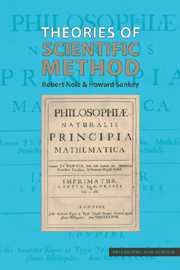Book contents
- Frontmatter
- Contents
- Abbreviations
- Acknowledgements
- Introduction
- I The idea of methodology
- 1 What is this thing called scientific method?
- 2 Theoretical values in science
- 3 Rules and principles of method
- 4 Metamethodology
- II Inductive and hypothetico-deductive methods
- III Probability and scientific method
- IV Popper and his rivals
- V Naturalism, pragmatism, realism and methodology
- Epilogue
- Notes
- Bibliography
- Index
3 - Rules and principles of method
from I - The idea of methodology
- Frontmatter
- Contents
- Abbreviations
- Acknowledgements
- Introduction
- I The idea of methodology
- 1 What is this thing called scientific method?
- 2 Theoretical values in science
- 3 Rules and principles of method
- 4 Metamethodology
- II Inductive and hypothetico-deductive methods
- III Probability and scientific method
- IV Popper and his rivals
- V Naturalism, pragmatism, realism and methodology
- Epilogue
- Notes
- Bibliography
- Index
Summary
In Chapter 2 a model of theory choice was presented in which values played a central role, but theory choice can also be governed by rules (alternatively norms, maxims or imperatives). In this chapter we shall discuss theories of scientific method understood as sets of rules of method or, as we prefer to say for reasons to be spelled out later, principles of method. Collections of such principles are commonly said to form theories of scientific method, and to embody the rationality of science. Section 3.1 sets out some commonly cited principles of method, some of the different kinds of principles there are, what connection there may be between values and principles and whether a principle or a value formulation of methodologies is preferable. Other historically proposed principles of method will emerge in §§3.3–3.5 and elsewhere throughout the book. Principles of method have some important features, such as reliability, robustness, power and speed. What these mean is spelled out in §3.2. Principles of method are not arbitrary and need to be justified in some way; this is the province of metamethodology, which is discussed in Chapter 4 (with further chapters setting out reasons for accepting or rejecting some putative principles of method). Features such as reliability, robustness, power and speed play an important role in critically assessing principles of method. After all, we do want reliable rules, we want them to apply in a wide range of possible epistemic situations and we want them to apply broadly to many theories and to be readily usable.
Information
- Type
- Chapter
- Information
- Theories of Scientific MethodAn Introduction, pp. 57 - 79Publisher: Acumen PublishingPrint publication year: 2007
